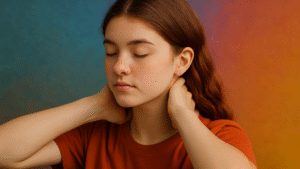In the modern world, many of us have become disconnected from nature in ways that impact our physiology, mood, and resilience. Across many cultures, barefoot contact with the ground has long been part of daily life, recognised as a natural, common health ritual. Integrative systems like naturopathy and bioregulatory medicine have also long affirmed the therapeutic value of reconnecting with Earth’s elemental forces. Learning about the basics and benefits of grounding, along with simple, accessible ways to incorporate it into our highly tech-saturated lives, is an essential yet often missing element of early education.
Grounding, also known as earthing – is the practice of bringing the body into direct contact with the earth’s surface to support natural physiological balance. At Vibrant Health Education (VHE), we see grounding as an example of applied health-building, a preventative practice supported by emerging biophysical research and consistent with integrative medical principles. It’s a reminder that some of the most effective health-supporting habits are simple, free, and available to all of us, including children and young people.
Firstly, what Is Grounding?
Grounding refers to direct skin contact with natural surfaces such as grass, soil, sand, or water. Modern research has shown that the Earth’s surface carries a subtle negative electric charge, and that physical contact allows our bodies to absorb free electrons. These electrons act as natural antioxidants, neutralising excess free radicals in the body.
Free radicals are unstable molecules that can damage cells, proteins, and DNA, contributing to inflammation, premature ageing, and chronic diseases when not neutralised. This physical exchange – of free radicals for electrons – has been linked to a wide range of health benefits including reduced inflammation, improved sleep, balanced nervous system function, and greater emotional stability.
Grounding and Health
The human body is in constant relationship with its environment, physically, biochemically and electrically. Clinical studies have shown that this simple practice can regulate cortisol rhythms, ease the stress response, and activate the parasympathetic nervous system. It also supports circulation, tissue repair, immune function and deeper, more restorative sleep.
In holistic healthcare, grounding and nature-based therapies are increasingly used in recovery from chronic fatigue, PTSD, anxiety, and pain management. In Sweden, the Skåne Model (Nature-Based Rehabilitation) offers patients therapeutic gardening and forest time as part of mental health treatment. In Norway, Villmarksterapi invites young people into wilderness settings for guided healing through nature connection and self-discovery. These programmes reflect a growing global awareness of the regenerative impact of nature.
In many Eastern cultures, including Chinese, Korean, and Japanese medicine, the body is understood as deeply influenced by its environment; and forests are seen as places that help restore physical and energetic balance. One reasons is the presence of phytoncides – organic compounds released by trees that easily evaporate into the air and can be absorbed through the breath. Research shows that phytoncides can lower stress hormones like cortisol, boost immune cell activity, and support parasympathetic dominance in autonomic nervous system balance. When combined with grounding practices like walking barefoot or resting under a tree, nature offers a powerful source for preventative health-building and restoration.
More than Barefoot in the Grass
At VHE, we see grounding as energetic hygiene – a practice that taps into the Earth’s subtle bio-electrical potential to rebalance us from overstimulation. Practically, this can mean walking barefoot on natural surfaces like soil, sand, or untreated wood, which act as conductive pathways for electrons to move into the body and help neutralise oxidative stress.
Nikola Tesla’s pioneering work reminds us that everything in nature fundamentally operates on frequency, energy, and vibration – including the human body. He demonstrated that electrical charge moves, resonates, and seeks grounding. Just as a Tesla (copper) coil releases excess energy into the air, the human body also generates electrical impulses; from brain waves and nerve signals to the subtle electrical charges in our cells.
When disconnected from natural conductive surfaces like soil or water, this electrical system can become imbalanced, contributing to chronic tension, inflammation, and fatigue. Grounding allows excess charge to safely discharge by making direct contact with the Earth’s surface. This excess charge (typically from overexposure of technological devices) is able to dissipate and the established circuit invites us into resonance with the planet’s natural (and healing) frequency, known as the Schumann resonance. Grounding, from this perspective, can also be seen as a form of bioelectric hygiene, rooted in the same fundamental laws of physics Tesla explored more than a century ago.
At home, grounding can be explored through simple practices: placing your hands on a tree, sitting on a large stone, or using a grounding mat with a verified earthing point – all simulate this discharge-recharge effect. Try one of the above the next time you feel overcharged or have spent too many hours on your electronic device. Even placing your fingers in soil can create a subtle but tangible shift. Try it the next time you feel overcharged – can you feel the shift?
Grounding, in its truest form, is the practice of reconnecting our bioelectric systems with the Earth’s natural electromagnetic field. In the classroom context, however, it becomes something more comprehensive: the creation of stable reference points for scattered energies and overwhelmed nervous systems. Think of your nervous system like smartphones running too many apps at one time, where without regular “charging,” “rebooting,” and “cache removal” the system becomes sluggish, unresponsive, and prone to crashes. So grounding offers our biological system that essential restart.
The question then becomes: How do we create grounding opportunities that work within the constraints of modern classrooms?
For young people, who are increasingly exposed to artificial environments, digital overload, and chronic stress, grounding offers a simple and empowering way to regulate energy, and thus, emotions. At VHE, we encourage schools and youth groups to explore grounding as part of a wider wellbeing toolkit.
Activities might include barefoot walks on grass or sand during break times, nature-based mindfulness sessions seated on the ground, or outdoor learning that incorporates movement, play, and stillness on natural surfaces. Gardening, tree care, and sensory interaction with soil also provide rich opportunities for grounding through tactile engagement. These practices strengthen young people’s self-regulation skills, helping them calm their nervous systems naturally without over-reliance on screens or external stimulation.
To deepen curiosity, we also invite student-led discussions around the body’s bioelectric nature; how the nervous system communicates through subtle currents; and how grounding helps stabilise these electrical signals. As a creative and hands-on classroom project, students can build orgonite pyramids using metals, crystals, and resin, learning how different organic and inorganic materials may influence electromagnetic fields and absorb energetic “noise.”
These practices not only promote personal wellbeing but nurture a deeper respect for the living systems that sustain us and the world around.
VHE’s Last Word
As our culture becomes more digitised and disconnected, practices that bring us back into harmony with the earth are no longer optional, if we seek health. They are wellbeing hacks and a part of a bigger-picture, and integrated health strategy.
At Vibrant Health Education, we believe grounding is for healing, learning, growing, and that is why it is an essential part of our applied health-building curriculum!✨
In Health,
#VHEdu❤️




